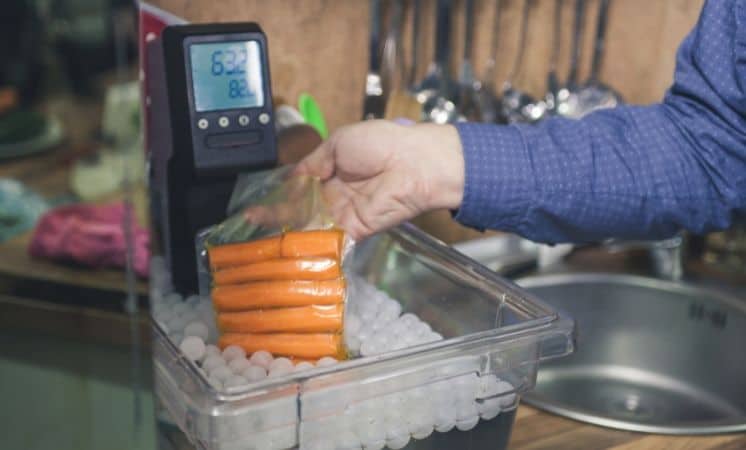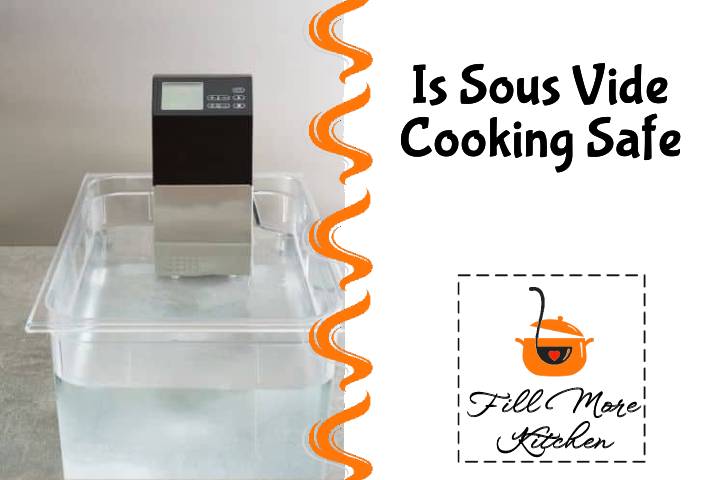The method of cooking known as sous vide, which was previously limited to use by skilled chefs in upscale restaurants, is gaining popularity due to its ability to produce perfectly cooked steaks, tender pork, and juicy chicken breasts.
Sous vide cooking entails immersing food in vacuum-sealed bags and a water bath to cook at an exact and regulated temperature. Safety concerns arise for many people when it comes to consuming food cooked in plastic bags.
Regarding the safety of sous vide cooking, it is indeed safe as long as the food is kept away from the temperature danger zone and food-grade bags are utilized.
Ensuring safety in sous vide cooking involves addressing the risks of chemical leaching, food-borne illnesses such as Salmonella, and ensuring thorough cooking.
Our investigation delves into the safety of sous vide for expectant mothers, its potential as a nutritious option, and its ability to eliminate harmful microorganisms. Continue reading to discover the true level of safety associated with this cooking method!
Is Sous Vide Safe When Pregnant?
Pregnant women should ensure that all the food they consume is fresh, clean, and cooked thoroughly instead of limiting themselves to certain foods, as consuming undercooked or raw food or those containing preservatives can be harmful.
As a result, sous vide is an excellent cooking technique for expectant mothers and is deemed “low-risk” in terms of food safety concerns. The food is uniformly cooked and will gradually reach the desired temperature over an extended period.
If you intend to consume sous vide-cooked meat and are pregnant, it is crucial to ensure that the meat has undergone thorough pasteurization to prevent the ingestion of harmful pathogens that could cause illness; this advice also applies to individuals who are not pregnant or at risk of becoming so.
Is Sous Vide Healthier?
Regarding healthiness, sous vide cooking is superior to other conventional cooking methods, and the following explains why.
Sous Vide Retains Nutrients & Vitamins.
Exposing food to high temperatures from boiling, frying, or steaming can cause a significant breakdown and destabilization of the nutrients present in the food.
When cooking food, essential nutrients and vitamins are often lost due to leaching or charring caused by overcooking or burning; however, with sous vide cooking, the nutrients and vitamins remain sealed within the pouch.
By using sous vide cooking, a greater amount of nutrients can be retained in and on the food, which may lead to increased consumption of vitamins and nutrients, resulting in improved overall health.
Food Is Easier to Digest.
When you cook your food, it enables the nutrients to be bioavailable, making them more accessible and easier to absorb during digestion. Although some vegetables need cooking for their nutrients to become bioavailable, animal proteins provide the most significant advantage.
Animal proteins such as fish, chicken, pork, and lamb contain a significant amount of collagen that provides benefits to our hair, skin, and nails; nevertheless, it may be challenging for the body to assimilate.
Using the sous vide cooking method can increase the breakdown of collagen into gelatin, making it more easily absorbed by the body.
You Will Have Stronger Joints & a Happier Gut.
Collagen is essential for maintaining the health of your connective tissue, such as ligaments, tendons, and fascia – a band of connective tissue that supports and attaches your skin to muscles and internal organs.
Collagen plays a vital role in regulating gut hormones, reducing the risk of skin aging, and providing essential nutrients to support connective tissue for optimal body function.
Additional Fats Are Not Required.
When using sous vide, there is no need to be concerned about food sticking to the cooking surface as with pan-frying, which eliminates the necessity for additional fats such as butter or oil during cooking, resulting in only consuming necessary good fats from the food without any excess.
You Can Prepare Meals in Advance.
Although we all desire nutritious and delectable meals, it is undeniable that they often require a significant amount of time for preparation and cooking.
Due to their convenience, many individuals opt for fast food menus or highly processed foods.
Utilizing sous vide cooking method allows for the preparation of bigger portions of nutritious dishes beforehand, promoting a reduction in dining out and an increase in homemade meals, which is crucial for maintaining a healthy lifestyle. It’s imperative to consume wholesome food if you aim to achieve optimal health, and your body will express gratitude for it.

Opting to prepare food at home results in a reduction of calorie intake as well as the consumption of fewer grams of carbohydrates, salts, and fats.
Utilizing sous vide cooking technique enables you to prevent nutrient loss and reduce the amount of additives used, while also allowing you to consume food that is easily digestible and in its most natural state.
By having full and accurate authority over the cooking process and the ingredients used in the pouch, you can determine a more healthful lifestyle.
Does Sous Vide Kill Parasites and Bacteria?
Sous vide cooking can be unsafe if the food is left in the temperature danger zone, which is between 40 degrees Fahrenheit to 140 degrees Fahrenheit or 4 degrees Celsius to 60 degrees Celsius, as this is one of the primary ways that food spoils.
If any food such as eggs, meat, seafood, cooked vegetables, pasta, beans, and raw sprouts remains in the temperature range for more than two hours, it becomes vulnerable to bacterial growth and parasites.
Consuming food that has been in the danger zone can lead to food-borne illness, but fortunately, all pathogenic bacteria are eliminated below 131 degrees Fahrenheit. That’s why most recipes suggest cooking at 140 degrees Fahrenheit or higher.
When using the sous vide method, recipes are typically fully pasteurized prior to consumption, ensuring that they are safe and devoid of any harmful pathogens. Achieving this requires maintaining a specific temperature for a set duration and ensuring that the food reaches this temperature throughout its entirety.
The required temperature varies depending on the food being cooked using Sous Vide technique.
To pasteurize a one-inch chicken breast and kill off virtually all Salmonella, it should be cooked at 165 degrees Fahrenheit or 74 degrees Celsius, which is the temperature that causes the core of the chicken breast to reach this level.
Reducing the temperature to 150 degrees Fahrenheit or 65.5 degrees Celsius can eliminate all Salmonella in three minutes, which means that a one-inch chicken breast cooked using sous vide at this temperature would require 47 minutes of cooking time to ensure complete Salmonella elimination.
Note that additional time is required to account for the duration it takes for the food to attain the desired temperature. For instance, in the case of chicken breast, if you aim to fully pasteurize it, it must be immersed in sous vide for 1 hour and 36 minutes.
Simply put, sous vide cooking is safe as long as the temperature is set above 131 degrees Fahrenheit and the cooking time exceeds 30 minutes, effectively eliminating bacteria and parasites.
What About All That Plastic?
As long as you use plastic bags that are safe for food, it is generally considered safe to use them for sous vide cooking. However, certain types of plastic can release harmful chemicals like Bisphenol-A (BPA) into the food, which is why some individuals have opted not to reuse plastic containers for storing food.
It is important to use high-density polyethylene or polypropylene bags for sous vide cooking as they can withstand the sub-boiling temperatures used in this method. To avoid any concerns about additives, opt for bags from manufacturers that do not include plasticizers.
You can also check this video about “Is Sous Vide Cooking Safe?”
Check out our top 10 reviews!
Related posts
https://fillmorekitchen.com/can-you-boil-eggs-in-a-microwave/
https://fillmorekitchen.com/can-you-boil-water-in-an-instant-pot/
https://fillmorekitchen.com/food-that-should-not-be-dehydrated/
https://fillmorekitchen.com/can-you-really-put-aluminum-foil-in-a-dehydrator/
https://fillmorekitchen.com/should-you-put-hot-or-cold-water-in-a-slow-cooker/



